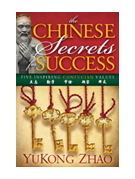In a recent interview, Fareed Zakaria, the host of CNN’s Global Public Square show, asked his guests--- “Tiger Mom” Amy Chua and her husband Jed Rubenfeld, to explain a puzzling phenomenon: in spite of overwhelming success stories of Chinese Americans and Indian Americans, China and India still fall behind the U.S. in development and many other areas. Left unaddressed, this question was certainly baffling for the two authors of The Triple Package: How Three Unlikely Traits Explain the Rise and Fall of Cultural Groups in America and their vast readership. Frankly, I pondered this same “problematique” when writing my book The Chinese Secrets for Success: Five Inspiring Confucian Values.
To solve this thorny puzzle, I propose that we group success factors into two categories and analyze them differently. That is: the factors driving a nation’s progress and success are fundamentally different from determinants of personal and familial success, with the exception of several commonly shared ingredients such as education. When we apply the varied levels of analysis on national vs. individual achievements, we then can soundly assess and explicate the contrast between Chinese Americans’ success, on one hand, and the national gaps between China and the U.S.
A country’s development and success are contingent upon its political and socioeconomic institutions. Overall, these institutions are both historically and culturally constructed in a cumulative and path-dependent manner, with roots in collective wisdom and value systems throughout various human civilizations. For instance, ancient Greek philosopher Aristotle advocated for “rule of law”. French political philosopher Montesquieu during the Age of Enlightenment raised the theory of separation of powers, while Scottish political economist Adam Smith laid theoretical foundations of classical free market economic theories. On the contrary, institutionalization of fascism in Germany, Italy, and Japan had led to disastrous outcomes in human history. Superlative political and socioeconomic institutions help build superlative nations.
From a historical perspective, ancient China was home to one of the world’s most advanced sociopolitical and economic systems at the time, rendering it the leading nation of the globe for thousands of years. Due to influences of Confucian values, ancient Chinese rulers implemented policies of benevolence and prioritized people’s interests while the rest of the world were toiling in cruel slavery. For instance, the Roman Empire established the Catholic Church as the supreme power above people. By the same token, when other countries were still choosing their ruling classes based upon aristocratic heredity, China had invented the Imperial Examinations system (Ke Ju) to select candidates for its governing bureaucracy with an emphasis on merit, morality and knowledge. Notably, the Chinese Ke Ju system was open to all people, regardless of socioeconomic backgrounds. As a result, China was the first nation in the world to have achieved upward social mobility among its population. Moreover, the Confucian focus on education also advanced China’s economic development and technological innovation.
The ancient Chinese civilization reached its pinnacle during the Song dynasty (960-1279 AD) with an economy taking up over 50% of the world’s GDP at the time. China in the Song dynasty led the rest of the world by an impressive margin of several centuries in commerce, finance, manufacturing and technological innovation. Unfortunately, the advanced civilization was nearly destroyed by the Mongol conquest in the late 13th century. The subsequent dynasties--- Yuan (governed under the Mongol Empire), Min, and Qing (ruled by the Manchus), all established brutal political and economic regimes to impose the rulers’ interests over their people’s. Moreover, these later regimes also adopted economic isolationism by restricting industrial development, discouraging commerce and prohibiting foreign trade. As a result, the Chinese civilization stagnated and backslid.
At the same time when China entered an economic and technological hibernation, the West was developing exponentially during the Age of Enlightenment, the Industrial Revolution and the establishment of capitalism, subsequently. The Western world was able to build modern political and economic institutions which surpassed the Chinese regime by institutionalizing the rule of law, the free market economy, democracy and equal rights. The United States has stood out as a prime example of the West’s fateful catching up. Since the end of the World War II, the U.S. has become the world leader in economy, science and technology, as well as in military. Although China has recently begun to embrace and model upon modern political and economic regimes to certain degrees (such as the market economy and rule of law), it is still at a nascent stage in setting up modern governing structure and institutions. The institutional gap is precisely why China still lags behind the U.S. The unique challenges facing China are indeed structural, to include: corruption, environmental issues, food security and so on. These essentially institutional bottlenecks are not the same as various cultural aspects pertinent to individual and familial development.
On the individual level, the success of one person and one family is intricately related to a set of cultural values including individual and social norms regarding education, family, personal finance and moral compasses. So far as these cultural beliefs are concerned, Confucian teaching showcases an assortment of valuable lessons. “Determination for an outstanding life”, as one key concept of Confucius’ moral philosophy, encourages us to become self-driven toward meaningful goals and strive for these dreams through hard-work. By “pursuing an excellent education”, we can acquire high-quality skills and enter into desirable professions. When we “save for a better life”, financial security will arrive upon prudence and wise money management. In the value “caring for our families”, we learn to build and sustain loving and successful homes. Last but not least, the Confucian philosophy also teaches us to choose our friends wisely based on good virtues and sustainable relationships. Overall, the Confucian value system, as an important cultural heritage, has partially explained the collective resilience of many Asian Americans against negative influences of excessive consumption, anti-intellectualism, blind star worship, et al. According to a 2012 Pew Research Center survey, “Asian Americans are the highest-income, best-educated and fastest-growing racial group in the United States”. Many other polls have also demonstrated Asian Americans’ great performance in financial management and good family values, which lead to high saving rates and low rates in divorce, crime and obesity.
In my book’s introduction, I wrote: “After the Chinese emigrated to the US, they embraced and benefited from many important Western values such as rule of law, equal rights, and independent thinking. At the same time, they retained much of their own cultural heritage, predominantly Confucian values, such as the emphasis on education, saving, and devotion to the family. It is the combination of positive values drawn from both Confucianism and Western culture that make many Chinese/Asian Americans successful in their pursuit of the American Dream!”
To conclude, it is institutional weaknesses in both economic and political senses that make China lag behind the U.S. On the other hand, it is the Confucian value system with an emphasis on individual and family development that has promoted Chinese Americans’ success here.
Learning these underlying reasons will help our children better distinguish China’s institutional setbacks from its cultural essence. We should not simply reject the Chinese culture and engage in counterproductive self-pity due to the contemporary issues the Chinese regime faces. Rather, we must embrace our outstanding cultural traditions.
Note. Original Article (in Chinese) was published by backchina.com on March 9th, 2014. This English version was translated by Dr. Wenyuan Wu.



